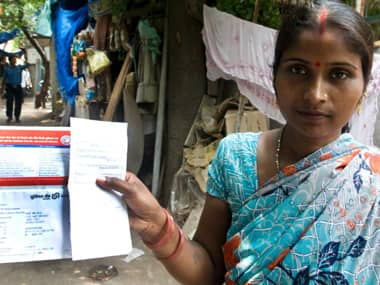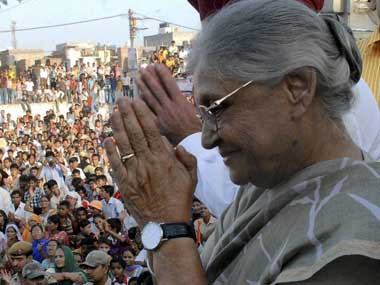Despite the fanfare with which it was launched in December last year by the Delhi Government, the ambitious Annashree Scheme, which was pitched as a food security scheme that involved a cash transfer of Rs 600 to those who didn’t have ration cards, doesn’t seem to have gotten off to a flying start with the voters. But with Centre’s implementation of the Food Security Ordinance, which is being touted as a game-changer with its massive target of 73 lakh beneficiaries in Delhi, three-time CM Sheila Diskhit has reason to celebrate as she readies for assembly elections in November.
With the first phase of implementation targeted at 35 lakh people, the Congress government in Delhi is racing against time to deliver the goods for election season. Delhi’s food and civil supplies minister in Haroon Yusuf, in a recent interview to Firstpost, described the food security ordinance as “great hope for people, especially the poor.”
The Annashree scheme, the state government’s first attempt at Aadhar-linked cash transfer, began as a scheme to benefit nearly 6 lakh of Delhi’s poor who had been identified by a survey conducted by Mission Convergence for the government three years ago.
But after only 70,000 out of the nearly 6 lakh of those originally surveyed were traceable, the government was forced to scale down its cash for food scheme to 2 lakh beneficiaries. Determined, however, to meet at least the scaled down target of 2 lakh, the government recently relaxed the eligibility criteria for the Annashree and empowered MLAs to recommend 500 families each for the scheme. Widows getting pension from the government were also included under the scheme.
Haroon Yusuf, Delhi government’s Food and Supplies Minister says he is quite hopeful that the government will reach its target of 2 lakh soon. In an interview to Firstpost to last week, Yusuf explained the rationale behind the Annashree scheme. “The Planning Commission has put a cap that we cannot go beyond 4.9 lakh BPL families. And in this category, 30 per cent fall under AAY or Antyodaya Anna Yojana (a central government scheme of food allocation for the poorest among the BPL families). The government decided that because there are a lot of people who are still living in a poor condition - their income is less than Rs 1 lakh and that is the criteria we have mentioned for Annashree - we thought that if we give this kind of opportunity they will get some support.”
[caption id=“attachment_962085” align=“alignleft” width=“380”]
 “The money under the scheme is less. But it is better than nothing,” says Kiran, a beneficiary of the Annashree scheme, which provides a cash transfer of Rs 600 per month for those without ration cards. Naresh Sharma/ Firstpost[/caption]
“The money under the scheme is less. But it is better than nothing,” says Kiran, a beneficiary of the Annashree scheme, which provides a cash transfer of Rs 600 per month for those without ration cards. Naresh Sharma/ Firstpost[/caption]
On the monthly amount of Rs 600, he said, “A BPL family gets 25 kg wheat, 10 kg of rice and 1.2 kg sugar. Based on the calculation of the difference in the amount they pay (against those who don’t get subsidised food), we started the scheme of Rs 600 per month. If they get Rs 600, they can buy egg or milk for protein. Or even medicine. With that aim we came up with the scheme. We put a cap of 2 lakh people. Already 1.06 lakh have been covered. We are hopeful that in the next 2-3 months we will be able to achieve the 2 lakh target.”
However, among those who are getting a monthly cash transfer of Rs 600, its impact on their level of food security, seems minimal.
[embedalsosee]
Says Kiran, mother of three and a resident of the Lal Gumbad slum cluster in Sheikh Sarai, “How much can we buy for Rs 600 when the price of everything has gone up so much,” she asks.
Her monthly food expenses, she says, comes up to Rs 4000-5000, of which she spends at least Rs 2000 on rice, wheat, dal and sugar.
But she goes on to add, “The money under the scheme is less. But it is better than nothing.” Kiran’s family of five lives in a one-room shack for which she pays a rent of Rs 2,500. Her husband earns a monthly salary of Rs 8000.
Asked whether she had heard about the new food security ordinance being introduced by the government, she says, “They bring schemes for those who hold ration cards. But we also vote. What about us?” (The Annashree beneficiaries are not likely to be included in the first phase of the implementation of the food security ordinance, which will be targeted at BPL ration card holders.)
Says Geeta Chauhan, also a Annashree beneficiary, “Just buying 20 kg of rice and 20 kg of wheat, at Rs 20 a kg adds up to Rs 800. With five children, how can I make do with Rs 600.” Asked if she thought if cash transfer was a good idea, she says, “It is a good scheme. But if we get ration cards, it would be better.”
Questioning the limited scope of the Annashree scheme, Anjali Bharadwaj, founder of citizen’s vigilance initiative Satark Nagrik Sangathan, says, “By their own survey about 6 lakh families who should have had BPL cards but didn’t have them were identified. What we were saying to the government was that they should be given ration cards so that they can get subsidised food under the public distribution system (PDS). That is the way they will get food security. However, instead of giving ration cards to these families the government said they will give Rs 600 every month…This is more like a dole that is going to be given out to families that don’t have ration cards.”
[caption id=“attachment_962093” align=“alignright” width=“380”]
 Delhi Chief Minister Sheila Dikshit. PTI[/caption]
Delhi Chief Minister Sheila Dikshit. PTI[/caption]
There is a fundamental problem with something like this. The first issue is, what is Rs 600 going to achieve. And how can you say this is for food security. It is not like you are replacing ration with money and saying that we are giving this money in lieu of ration. Rs 600 does not fetch a family anything close to what they need to sustain themselves. It is even lower than the subsidy that the government is giving on the BPL card, it is half of that. So people have understood that this is not a food security measure. They are looking at it as a pre-election gimmick."
Then, of course, is the question, of whether the cash transfer will be used to buy food. “Even if money comes to the bank account, there is no guarantee that it will be used for food. It can be used any way the family wants, it doesn’t necessarily lead to food security,” says Bharadwaj.
Nevertheless, the drive to enlist as many of the 2 lakh under Annashree before July 31 (the cut-off date of those eligible for arrears from April) by Delhi government is on full throttle.
Also progressing at frenetic pace, is the implementation of Food Security Ordinance - which looks set to be the centre-piece of Sheila Dikshit’s election campaign.
Close to seventy per cent of Delhi’s voting population will be entitled to food security under the ordinance which entitles beneficiaries to 5 kg food-grain per person at Rs 3 per kg of rice, Rs 2 per kg of wheat and Re 1 per kg of coarse grain.
To be implemented in two phases - most vulnerable and vulnerable , the first phase will cover those with BPL cards, jhuggi ration cards, resettlement colony ration cards and AAY cards. Together they comprise 5.1 lakh families or 32 lakh individuals.
According to a senior official in the Food and Supplies department, the plan is to start rolling out the entitlements as early as September. For the second phase, applications will be invited under to specific criteria.
While there will be no change in entitlements for AAY card holders who are receiving food grains at rates prescribed under the Food Security Ordinance, the food prices for BPL card holders under the food security ordinance will come down and the entitlement will be expanded to per person.
)